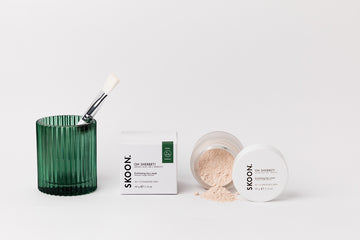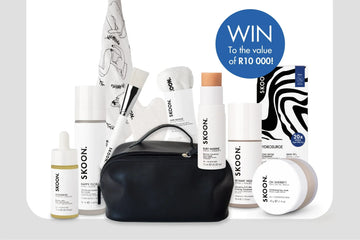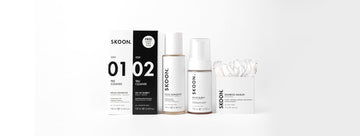Let’s talk about:
- What is Azelaic Acid?
- What are the benefits of Azelaic Acid in Skincare?
- What are the side effects of Azelaic Acid?
- Azelaic Acid myths and misconceptions
- How do I use Azelaic Acid as part of my skincare routine?
- When should I expect to see results?
- Which products with Azelaic Acid should I try?
Azelaic Acid popped up on my radar sometime during the middle of 2019 (although it has been building momentum for a couple of years already).
Once a week I would sit on my couch with a view of the Stellenbosch mountains and chat to SKOON.’s chemist about trending ingredients. To say he was enthusiastic about Azelaic Acid would be a gross understatement ☺. After looking at all the research on this ‘rising star’ ingredient I found myself equally excited.
Here are all the reasons!
Possibly the fact that Azelaic Acid has all the makings of a stellar skin care ingredient.
Definitely the fact that Azelaic Acid is quite a comprehensive multi-tasker. Multi-tasking ingredients are the differentiators between good and great skin care.
Now, as you all know I always start a blog with a sweet treat and a cup of coffee. A cold, almost-Spring day like today calls for a slice of warm apple tart with a blob of cream…but no, I am on a 90 day sugar detox so today let’s just share a cup of coffee (on my side I am secretly hoping three months will pass in a flash!)
Back to the topic at hand. Let’s find out more!

What is Azelaic Acid?
The good news first. Your skin is familiar with Azelaic Acid since it is a natural by-product produced by yeast called Malassezia furfur that forms part of your skin microbiome (just a fancy collective term for your healthy skin flora).
I see a lot of blogs referring to the fact that Azelaic Acid is also found in whole grains like wheat, rye, barley, oats and sorghum. Hmm… this is certainly a long and impressive list and leaves the impression of skincare brands bashing wheat around to harvest Azelaic Acid ☺.
In reality, most of the Azelaic Acid used in skin care products is lab-engineered for maximum stability and effectiveness. At SKOON. we use Azelaic Acid made from RSPO certified palm oil – so no worries about gluten.

What are the benefits of Azelaic Acid in Skin Care?
Azelaic Acid has migrated from medicinal topical applications for acne and rosacea to mainstream skin care due to the fact that it is so effective, yet so mild, with virtually no side effects. Any medicinal ingredient needs to be extremely consistent, hence the fact that Azelaic Acid is mostly bio-engineered to deliver just this.
Effective, consistent results.
Reduce acne and clear pores of bacteria
The treatment of acne, acne-prone and clog-prone skin involves several basic steps. The first step is daily follicular exfoliation. The basis of this step is to use ingredients like enzymes, alpha hydroxy acids or keratolytics to help the inside of the follicle to exfoliate, breaking loose cell buildup and solidified sebum, loosening clogged pores and drying visible lesions.
Azelaic Acid is a keratolytic (like Vitamin A) and its real value lies in the breakup of microcomedones (small impactions formed by cells that have built up on the inside of the follicle wall – think blackheads, whiteheads) that already exist. It also functions to keep hyperkeratosis (btw, hyperkeratosis is hereditary, the reason why you find acne running in a family) from accumulating, to form new microcomedones.

If you want to know more about exactly how a keratolytic helps keep your skin clear, read my blog on another potent keratolytic, Vitamin A. Keep in mind Azelaic Acid is not a retinoid but both Vitamin A & Azelaic Acid are keratolytics.

I guess you now may want to know what the difference is between Vitamin A and Azelaic Acid.
Good question ☺.
How Azelaic Acid compares to other anti-acne ingredients like Vitamin A
The simple answer is quite good actually. Azelaic Acid is on a par with Vitamin A when it comes to controlling acne. But..and this is a big but…there is more to this simple answer. We need to look at some numbers to really compare these two mega ingredients.
(Wish I could reach for a slice of apple tart now ☺)
I know you want to skip the maths but bear with me. I think it is important to know, especially if you are struggling with acne and are looking for an effective solution.
Azelaic Acid comes in two forms: prescription medicine and normal skincare. The difference lies in the percentage of Azelaic Acid used in a formula. Prescription products contain 15%-20% Azelaic Acid and skincare products usually have around 10% in the case of wash-off products and 3% for leave-on products.
If you have grade III-IV acne, cystic acne or uncontrollable fungal acne I would recommend a speedy trip to your doctor to discuss prescription Azelaic Acid cream e.g. Azelex® - as a possible option. According to numerous studies, the results are the same if you use 15% Azelaic Acid or Accutane or 0.05% Retinoic Acid.
If you want to continue with long term maintenance after the use of either Accutane or prescription Azelaic Acid or simply want to control sporadic hormonal breakouts or blackheads, look no further than SKOON’s OH SHERBET! 10% Azelaic acid exfoliating mask. (PS: Just launched!).
Like I said at the beginning of this blog – you can’t go wrong with this multi-tasking on-trend ingredient.…and our lovely, 100% natural mask is such an easy way to incorporate this powerhouse exfoliant in your beauty routine.
Let’s have a quick peek at some of the other superb benefits.
Reduce visible redness in rosacea
No one is completely sure of the exact cause of rosacea but it appears to be hereditary and is related to how easily you blush! Makes sense then that it is more prominent in people with fair skin.
Rosacea is primarily an inflammatory disorder and symptoms may include extensive flares of redness, acne-like bumps and distended capillaries. You can have either “dry rosacea” or a type of “acne rosacea”.
It will come as no surprise then that the most effective ingredients to address rosacea symptoms (nope, there is no cure!) are those with significant anti-inflammatory properties. Enter our multi-tasking hero ingredient “Azelaic Acid”.
As I have previously mentioned Azelaic Acid has migrated over to skincare from medicine due to the fact that it has demonstrated significant anti-inflammatory activity in addition to being an effective anti-acne agent. Prescription products to treat rosacea will contain around 15% Azelaic Acid.
Skincare products containing 3% Azelaic Acid are perfect for long term maintenance treatment when your flares are in remission. Don’t forget to boost your topical Azelaic Acid with antioxidants like Vitamin C (WOW-WOW WONDER 3-Hyaluron + C serum) for more effective results – there is a link between damage from free radicals and rosacea.
Rosehip oil is another ingredient that is incredibly effective at treating rosacea, reducing inflammation and getting rid of blemishes.
Boosting tone and reducing pigmentation
Hyperpigmentation is both a long- and short-term cosmetic problem caused by the sun (and we certainly do have lots of sun in sunny South Africa!). It manifests as dark splotches on your skin and may appear suddenly, especially if you are a woman, after years of sun exposure. Even if your hyperpigmentation is caused by hormones or medicine, sun exposure is still the major factor determining whether your pigmentation will improve or worsen.
In general, hyperpigmentation is treated with 3 basic steps:
❶ Exfoliation, to remove existing splotches.
❷ Use of melanin-suppressing ingredients to stop the formation of new splotches.
❸ Effective sun care to minimise the formation of new splotches.
Let’s have a look at what Azelaic Acid can do for pigmented skin.
Besides being an effective exfoliant (sure do hope you know this off pat by now), Azelaic Acid also blocks the melanin-producing enzyme tyrosinase – making it a double-duty guy. This makes Azelaic Acid a keratolytic (exfoliator) and a melanin-suppressant.
Hyperpigmentation is what I call a “long hauler”. There are no quick solutions but with some perseverance and a multi-tasking ingredient like Azelaic Acid in your beauty toolkit there is certainly scope for improvement.
What are the side effects of Azelaic Acid?

This is what makes Azelaic Acid so good - and versatile. It has numerous functions and treats a variety of skin concerns without any serious side effects.
A keeper ☺.
Azelaic Acid myths and misconceptions
“Azelaic Acid contains gluten, and if I apply it, I’ll have an adverse reaction due to my gluten intolerance..”
As mentioned earlier, there may be confusion around the fact that certain grains contain Azelaic Acid.
At SKOON. we use (gluten-free) Azelaic Acid, bio-engineered from RSPO certified palm oil. So, no worries there.
If you are concerned, you need to contact the relevant brand, to clarify their source.
How do I use Azelaic Acid as part of my skincare routine?

This will depend on what type of Azelaic Acid product you are using.
SKOON. has just launched an easy-to-use 10% Azelaic Acid clay mask. You can use OH SHERBET! Azelaic acid 10% exfoliating clay mask daily for breakouts. The light pink clay is super absorbent and will further help to mop up excess oil and dry out bumps and blemishes. Although OH SHERBET! is a wash-off mask you can also spot treat individual breakouts with dabs of clay mask and leave it on overnight.
When should I expect to see results?
How long is a piece of string ☺?
Acne, rosacea and hyperpigmentation are all “long haulers”. Results will not be overnight. That being said there should be visible improvements fairly quickly.
If you do not notice an improvement that excites you within the first 3-4 weeks, I suggest you revisit your products and routine.

Which products with Azelaic Acid should I try?
Have a look at these two.
OH SHERBET! Azelaic acid 10% exfoliating mask WHITEWASH Purifying cleanser (with 1% Azelaic Acid).
Pheww… writing without my sidekick sugar is only half the fun! As always, leave your comments and questions.






Hi Stella, thank you for this informative blog, just used the mask this morning, hence I decided to read this blog. I wanted to know if it’s normal to get a stinging sensation whilst wearing the mask?
Thank you so much for this informative post.
Is azelaic acid safe during pregnancy? Vitamin A in retinols extremely dangerous. Curious to know more?:)
Hi there. I’ve just come off the pill (was taking it for acne but it messed up other things) and the last time I did that (5 years ago), I got nasty acne (I’m 36 now). I don’t want to return to using the pill for acne control. My skin is combo but I have dry cheeks. I’m using the vit c serum, the retinin cream and the one moisturizer. So my question – how often would you say I should use this new mask? I don’t actually have active breakouts. But I want to prevent them at all costs.
Is melanin not good for you?